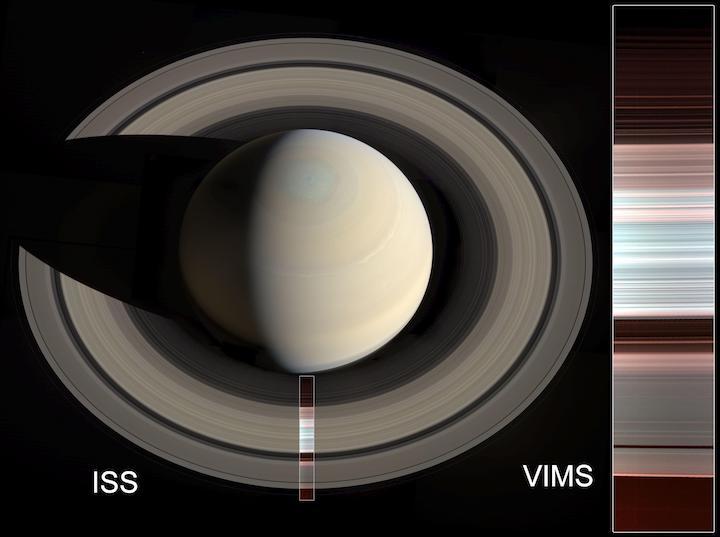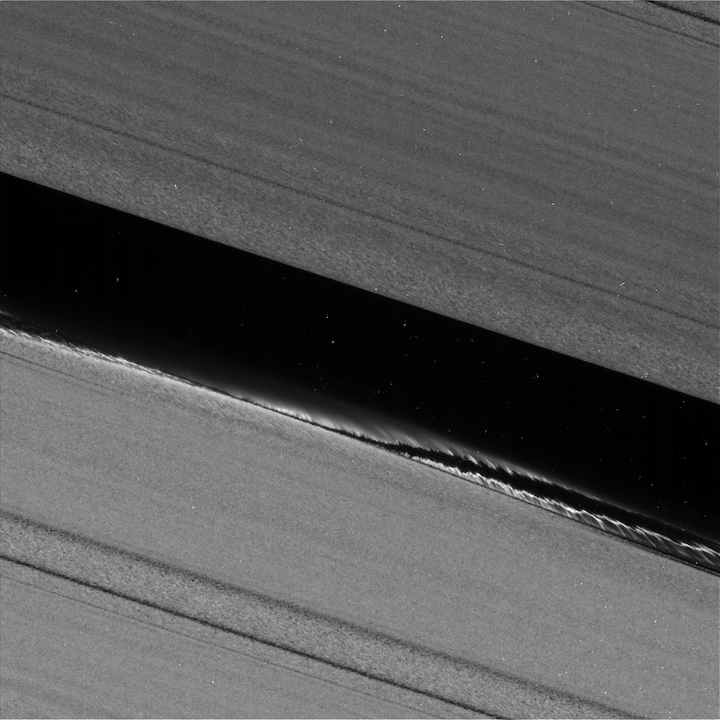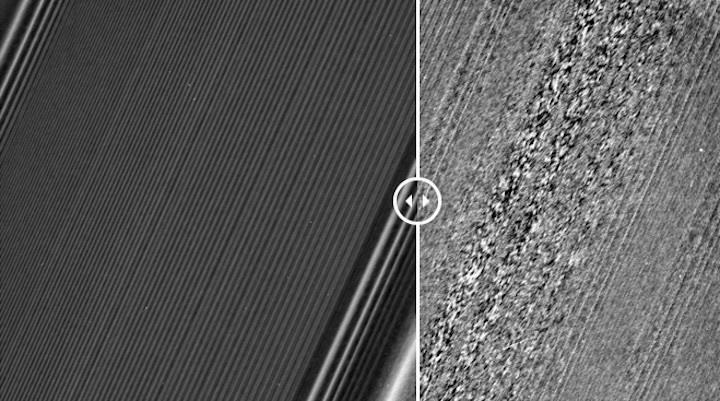14.06.2019

The false-color image at right shows spectral mapping of Saturn's A, B and C rings, captured by Cassini's Visible and Infrared Mapping Spectrometer (VIMS). It displays an infrared view of the rings, rather than an image in visible light. The blue-green areas are the regions with the purest water ice and/or largest grain size (primarily the A and B rings), while the reddish color indicates increasing amounts of non-icy material and/or smaller grain sizes (primarily in the C ring and Cassini Division).
At left, the same image is overlaid on a natural-color mosaic of Saturn taken by Cassini's Imaging Science Subsystem.

This enhanced-color image mosaic shows Daphnis, one of the moons embedded in Saturn's rings, in the Keeler gap on the sunlit side of the rings. Daphnis is seen kicking up three waves in the gap's outer edge. Three wave crests of diminishing sizes trail the moon. In each successive crest, the shape of the wave changes as the ring particles within the crest interact and collide with each other. A thin strand of ring material to the lower left of Daphnis is newly visible in this image, and there are intricate features that also hadn't been previously observed in the third wave crest downstream (see Figure 1).
Cassini was at a very shallow angle above the rings (only about 15 degrees) when this image was taken. The resulting foreshortening makes it difficult to tell the difference in this image between features representing vertical structure and those representing radial, or outward from Saturn, structure within the ring plane. Nonetheless, Cassini imaging scientists have determined that the waves in the gap are largely vertical; compare this to the shadows that they were seen to cast during equinox (see PIA11547, PIA11653, PIA11655 and PIA11656). The thin strand of material is also probably vertical. Daphnis itself is actually five times smaller than the width of the gap, but it looks bigger here because of the foreshortening.
The color in this image comes from using Imaging Science Subsystem images obtained by applying different filters to "paint" color onto the black-and-white version of this view previously released as PIA17212. The color of the ring region outward of the Keeler Gap (the "trans-Keeler region," in the lower portion of this image) is noticeably different from the color inward from the gap (upper portion of this image). In visible light, this color difference sharply coincides with the gap, while near-infrared Visible and Infrared Mapping Spectrometer (VIMS) images show some bleeding of the trans-Keeler region into the region inward from the gap. The reasons for the sharp change in color are mysterious, but they probably have more to do with a change in particle sizes and other properties than with a change in composition.
The images in this mosaic were taken in visible light, using the Cassini spacecraft narrow-angle camera at a distance of approximately 17,000 miles (28,000 kilometers) from Daphnis and at a Sun-Daphnis-spacecraft angle, or phase angle, of 71 degrees (for the color images, 58 degrees). Image scale is 550 feet (170 meters) per pixel.
The image was produced by Tilmann Denk at Freie Universität in Berlin.
Figure 1 shows a closeup of the third wave crest (toward the far left in the color image) focusing on detail scientists hadn't seen before, with multiple strands of ring material visible. The image shows how the ring material behaves after losing the structure Daphnis triggered and goes back to interacting with itself.
The ribbon of material that appears to be protruding into the gap in the right-hand portion of the image is probably actually soaring above the ring plane. Toward the left-hand part of the image, that same ribbon of material dives below the ring plane and becomes obscured by the main part of the rings, which is why it disappears from view.

Fig.1
The image shown in Figure 1 was taken in visible light, using the Cassini spacecraft narrow-angle camera at a distance of approximately 15,000 miles (23,000 kilometers) from Daphnis and at a Sun-Daphnis-spacecraft angle, or phase angle, of 94 degrees. Image scale is 520 feet (160 meters) per pixel. Unlike the main image, the image in Figure 1 was taken on the unlit side of the rings.
As NASA's Cassini dove close to Saturn in its final year, the spacecraft provided intricate detail on the workings of Saturn's complex rings, new analysis shows.
Although the mission ended in 2017, science continues to flow from the data collected. A new paper published June 13 in Science describes results from four Cassini instrumentstaking their closest-ever observations of the main rings.
Findings include fine details of features sculpted by masses embedded within the rings. Textures and patterns, from clumpy to strawlike, pop out of the images, raising questions about the interactions that shaped them. New maps reveal how colors, chemistry and temperature change across the rings.


New images of Saturn's rings show how textures differ even in close proximity of one another. The image on the right has been filtered so that the newly visible strawlike textures and clumps are more visible. Credit: NASA/JPL-Caltech/Space Science Institute
Like a planet under construction inside a disk of protoplanetary material, tiny moons embedded in Saturn's rings (named A through G, in order of their discovery) interact with the particles around them. In that way, the paper provides further evidence that the rings are a window into the astrophysical disk processes that shape our solar system.
The observations also deepen scientists' understanding of the complex Saturn system. Scientists conclude that at the outer edge of the main rings, a series of similar impact-generated streaks in the F ring have the same length and orientation, showing that they were likely caused by a flock of impactors that all struck the ring at the same time. This shows that the ring is shaped by streams of material that orbit Saturn itself rather than, for instance, by cometary debris (moving around the Sun) that happens to crash into the rings.
"These new details of how the moons are sculpting the rings in various ways provide a window into solar system formation, where you also have disks evolving under the influence of masses embedded within them," said lead author and Cassini scientist Matt Tiscareno of the SETI Institute in Mountain View, California.
Enduring Mysteries
At the same time, new puzzles have arisen and old mysteries have deepened with the latest research. The close-up ring images brought into focus three distinct textures - clumpy, smooth and streaky - and made it clear that these textures occur in belts with sharp boundaries. But why? In many places the belts aren't connected to any ring characteristics that scientists have yet identified.
"This tells us the way the rings look is not just a function of how much material there is," Tiscareno said. "There has to be something different about the characteristics of the particles, perhaps affecting what happens when two ring particles collide and bounce off each other. And we don't yet know what it is."
The data analyzed were gathered during the Ring Grazing Orbits (December 2016 to April 2017) and the Grand Finale (April to September 2017), when Cassini flew just above Saturn's cloud tops. As the spacecraft was running out of fuel, the mission team deliberately plunged it into the planet's atmosphere in September 2017.
Cassini's Visible and Infrared Mapping Spectrometer (VIMS) uncovered another mystery. The spectrometer, which imaged the rings in visible and near-infrared light, identified unusually weak water-ice bands in the outermost part of the A ring. That was a surprise, because the area is known to be highly reflective, which usually is a sign of less-contaminated ice and thus stronger water ice bands.
The new spectral map also sheds light on the composition of the rings. And while scientists already knew that water ice is the main component, the spectral map ruled out detectable ammonia ice and methane ice as ingredients. But it also doesn't see organic compounds - a surprise, given the organic material Cassini has discovered flowing from the D ring into Saturn's atmosphere.
"If organics were there in large amounts - at least in the main A, B and C rings - we'd see them," said Phil Nicholson, Cassini VIMS scientist of Cornell University in Ithaca, New York. "I'm not convinced yet that they are a major component of the main rings."
The research signals the start of the next era of Cassini science, said NASA's Ames Research Center's Jeff Cuzzi, who's been studying Saturn's rings since the 1970s and is the interdisciplinary scientist for rings on the Cassini mission.
"We see so much more, and closer up, and we're getting new and more interesting puzzles," Cuzzi said. "We are just settling into the next phase, which is building new, detailed models of ring evolution - including the new revelation from Cassini data that the rings are much younger than Saturn."
The new observations give scientists an even more intimate view of the rings than they had before, and each examination reveals new complexities, said Cassini Project Scientist Linda Spilker, based at NASA's Jet Propulsion Laboratory in Pasadena, California.
"It's like turning the power up one more notch on what we could see in the rings. Everyone just got a clearer view of what's going on," Spilker said. "Getting that extra resolution answered many questions, but so many tantalizing ones remain."
The Cassini-Huygens mission is a cooperative project of NASA, ESA (European Space Agency) and the Italian Space Agency. JPL, a division of Caltech in Pasadena, manages the mission for NASA's Science Mission Directorate in Washington. JPL designed, developed and assembled the Cassini orbiter. The radio antenna was built by JPL and the Italian Space Agency, working with team members from the U.S. and several European countries.
Quelle: NASA
